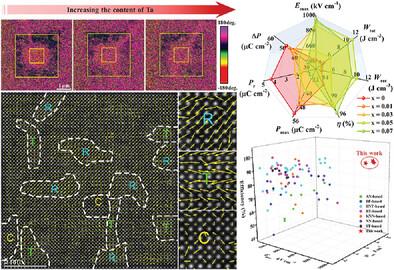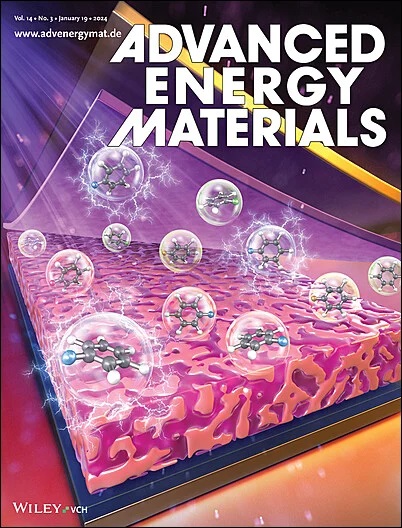Tape‐Casting Lead‐Free Dielectrics Permit Superior Capacitive Energy Storage Performance
IF 24.4
1区 材料科学
Q1 CHEMISTRY, PHYSICAL
引用次数: 0
Abstract
Dielectric capacitors have garnered significant attention for their promising attributes in advanced pulse power systems of the future, owing to their rapid charge/discharge capabilities, high power density, and remarkable stability. Whereas environmentally friendly lead‐free ceramics are facing serious challenges of low breakdown strength, poor energy storage density, and/or conversion efficiency, which has been an obstacle to developing desirable dielectric capacitors. In this study, high‐quality ultrathin (<20 µm) lead‐free ceramic dielectrics are successfully produced via the tape‐casting method. The local structural characteristics of these ceramics are verified using piezoresponse force microscopy and aberration‐corrected scanning transmission electron microscopy. By introducing Ta

无铅带状电介质可实现卓越的电容储能性能
电介质电容器因其快速充放电能力、高功率密度和出色的稳定性,在未来先进脉冲功率系统中具有广阔的应用前景,因而备受关注。然而,环保的无铅陶瓷却面临着击穿强度低、储能密度低和/或转换效率低的严峻挑战,这一直是开发理想电介质电容器的障碍。在这项研究中,通过胶带铸造法成功生产出了高质量的超薄(20 微米)无铅陶瓷电介质。使用压电响应力显微镜和像差校正扫描透射电子显微镜验证了这些陶瓷的局部结构特征。在 Bi0.39Na0.36Sr0.25TiO3 陶瓷中引入 Ta5+ 离子后,极性簇有一起减少的趋势,而最大外加电场却有增加的趋势。这一现象可归因于晶粒尺寸的减小和极性团簇极小的复杂极性结构,从而能够同时实现高外加电场、大极化和最小极化滞后。值得注意的是,在 915 kV cm-1 的高电场下,胶带浇铸的无铅陶瓷表现出卓越的综合储能性能,其可回收储能密度≈10.06 J cm-3,效率≈93%,超越了大多数已报道的无铅陶瓷的性能。这项工作为开发具有出色储能能力的无铅陶瓷电介质提供了可行的解决方案。
本文章由计算机程序翻译,如有差异,请以英文原文为准。
求助全文
约1分钟内获得全文
求助全文
来源期刊

Advanced Energy Materials
CHEMISTRY, PHYSICAL-ENERGY & FUELS
CiteScore
41.90
自引率
4.00%
发文量
889
审稿时长
1.4 months
期刊介绍:
Established in 2011, Advanced Energy Materials is an international, interdisciplinary, English-language journal that focuses on materials used in energy harvesting, conversion, and storage. It is regarded as a top-quality journal alongside Advanced Materials, Advanced Functional Materials, and Small.
With a 2022 Impact Factor of 27.8, Advanced Energy Materials is considered a prime source for the best energy-related research. The journal covers a wide range of topics in energy-related research, including organic and inorganic photovoltaics, batteries and supercapacitors, fuel cells, hydrogen generation and storage, thermoelectrics, water splitting and photocatalysis, solar fuels and thermosolar power, magnetocalorics, and piezoelectronics.
The readership of Advanced Energy Materials includes materials scientists, chemists, physicists, and engineers in both academia and industry. The journal is indexed in various databases and collections, such as Advanced Technologies & Aerospace Database, FIZ Karlsruhe, INSPEC (IET), Science Citation Index Expanded, Technology Collection, and Web of Science, among others.
 求助内容:
求助内容: 应助结果提醒方式:
应助结果提醒方式:


